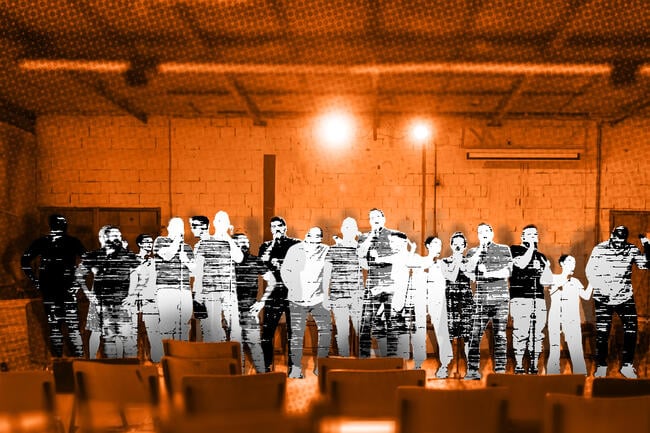You have /5 articles left.
Sign up for a free account or log in.

There are many more actors coming out of musical theater B.F.A. programs than there are jobs available in the industry, actor and professor Josh Grisetti argued in a popular TikTok post.
Photo illustration by Justin Morrison/Inside Higher Ed | guruXOOX/iStock/Getty Images
The number of colleges offering bachelor of fine arts degrees in musical theater has skyrocketed in recent decades to about 150 programs nationwide, according to academics in the field. Some are questioning whether that’s too many.
In a recent TikTok video, Josh Grisetti, an associate professor of musical theater at California State University, Fullerton, and an actor who has starred in Broadway musicals, argued that the glut of B.F.A. programs has led to too many young actors vying for a tiny number of performance jobs.
He doesn’t think that’s an accident.
“I don’t think that the system broke down at random,” he says in the video. “I think it broke down in response to more colleges creating more B.F.A. programs, not because they were equipped to have those programs, but because they thought they would be cash cows—and they were.” He goes on to claim that he knows of one institution that doubled the size of its B.F.A. cohort in order to earn more revenue from tuition.
Musical theater B.F.A. programs are intended to provide intensive training for students who hope to perform professionally. Their curricula train students to be “triple threats”—excellent singers, actors and dancers—and generally culminate in senior showcases, where the graduating classes perform for agents and casting directors who work in New York.
The first such program opened in the 1960s at the University of Cincinnati’s College-Conservatory of Music, just as higher education was “becoming sort of the pathway to the American dream,” said Laura London Waringer, an assistant professor of musical theater at Tulane University who is writing a book on musical theater training. A few exclusive programs followed thereafter, but the boom in B.F.A.s came in the 2000s as shows like Glee “really brought that kind of singing and musical theater performance into our living rooms and into the cultural zeitgeist in a way that it hadn’t been in the past,” she said.
But as new programs continue to crop up, Grisetti and several other professors of musical theater argue, many are not providing the tools students need to succeed—nor are they being selective about the students who pass through their programs.
“What many schools did to create music theater programs is they would say, ‘Well, we have a music program, and we have a theater program, so now we’re going to combine them.’ What you end up getting is sort of a patchwork-y kind of program where you have educators who are not specialists in this art form,” said Victoria Bussert, who is spearheading a new musical theater program at Oberlin Conservatory, though the program will be a bachelor’s of music, rather than a B.F.A. She has also consulted for B.F.A. programs in the past.
“If you don’t have a faculty whose expertise is this art form, you may be getting an education that is not contemporary, because we are a very fluid art form … you can’t just say, ‘Yes, we teach contemporary singing—we teach Les Mis!’ Well, that was many, many years ago. Do you teach Maybe Happy Ending? Do you teach The Outsiders? Do you teach Hell’s Kitchen?” Bussert said, referencing three musicals that opened on Broadway in 2024.
The discourse comes amid ongoing debates over gainful-employment regulations established by former president Joe Biden, which require academic programs to demonstrate that their graduates earn more than those without a college education and that they can afford to repay their student loans. Theater—like many arts and humanities degrees—is often stereotyped as a credential that leads students into debt and destitution. Though that is a simplification of the challenges theater majors often face, some theater programs have, indeed, failed to produce positive employment outcomes.
In 2017, for example, the Education Department cataloged programs whose graduates didn’t earn enough to cover their student loans. While most were at for-profit institutions, a graduate theater program at Harvard University was one of the few at a nonprofit college to fail to meet that metric.
Showcases and Performances
In the social media storm that followed Grisetti’s video, many B.F.A. alumni talked about the ways in which their B.F.A. programs failed to prepare them for performance careers.
Some said they graduated from a B.F.A. program without ever performing in a show because their programs had too many students—even though the National Association of Schools of Theatre, the accrediting body for theater programs, states that musical theater B.F.A. students must “participate in at least one fully produced major musical production during their course of study.” Others said their institution had denied them a showcase in front of New York agents, either canceling it for logistical reasons or requiring seniors to audition in order to be included.
“I feel like if you don’t have a showcase model, I don’t think you should be a B.F.A. program, which is geared toward vocational training,” Grisetti said in an interview with Inside Higher Ed. “If you’re not building that bridge into that industry, to me, you’re sort of saying, ‘Well, this is more generalist training and it’s meant to be universal’ … and in that sense, I think you would be better serving students having a B.A. program.”
Seniors in Grisetti’s program, on the flip side, spend an all-expenses-paid week in New York as part of their showcase, during which they also see a slew of Broadway shows, participate in dance workshops and master classes, and perform at 54 Below, a cabaret venue located under Studio 54, the historic nightclub turned Broadway theater. Cal State Fullerton also requires students to participate in two shows over the course of their degree, which Grisetti said “does not seem like a huge task”—unless a program has an enormous number of students in each class.
Bussert said that Oberlin’s new musical theater program will place a special emphasis on connections with the theater industry—including exclusive relationships with three local theater companies—and on helping students experience what it’s really like to work in professional theater.
That means having the opportunity to perform eight shows a week—which is the norm on Broadway but not in college theater, where most shows are held on the weekends—and an expectation that students will dance five days a week for their entire time in the program.
“Why? Because you need to do that in order to get hired,” she said.
‘Broadway or Bust’
Though Grisetti’s video was met with wide agreement, some argued the problems that exist within the theater industry—namely the lack of stable employment—shouldn’t mean that there should be fewer B.F.A. programs and, thus, fewer people given the opportunity to study theater. Others argued that B.F.A. programs should prepare students for the possibility that they may not make it as a performer by providing them education in aspects of the theater industry besides acting, singing and dancing.
Grisetti said he thinks it’s important that B.F.A. students know what transferable skills they’re gaining that they can apply elsewhere, but he doesn’t believe programs should alter their curricula to include, say, directing or arts management.
“There’s just not enough hours in the day for musical theater B.F.A. training, specifically—trying to teach three art forms in four years is already an insurmountable task. When you start adding on every possible career outcome, giving them exposure if not more in-depth training in any of those other areas, that’s just not a realistic expectation to put on these programs,” he said, noting that theater B.A. programs provide more of a broad, “choose-your-own-adventure” training.
Others said that Grisetti’s video was predicated on the idea that all B.F.A. students hope to end up on Broadway, despite the slew of other opportunities for actors in regional and off-Broadway productions, on national tours, at theme parks, and on cruises.
Waringer noted that while Broadway may not be the ultimate goal of all B.F.A. students, it is how programs promote themselves.
“It’s like, ‘Broadway or bust.’ Broadway is the dream. That’s how they market these programs: how many of their students are on Broadway. That’s the measure of success,” she said. “If we’re speaking specifically for a career on Broadway, there aren’t that many jobs to support a new graduating class of 1,500 students every year.”





